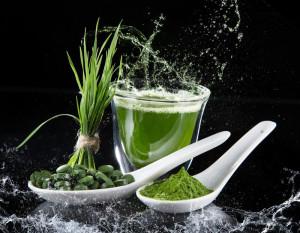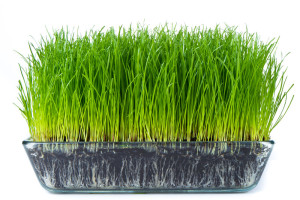 These days every second juice bar in the Mall has a tray of wheatgrass beckoning your body to down a shot and send you on your way to better health and unbelievable vitality. In other words, it is often tagged as another superfood (and many of you know how I feel about the use of the word ‘superfood’)
These days every second juice bar in the Mall has a tray of wheatgrass beckoning your body to down a shot and send you on your way to better health and unbelievable vitality. In other words, it is often tagged as another superfood (and many of you know how I feel about the use of the word ‘superfood’)
So let’s have a look and see if this ‘great grass’ is all that it is cracked up to be.
Most of us, when we hear the word wheatgrass, think of shots, smoothies, or some sort of all-natural health drink. While wheatgrass is better known as something you are most likely to find in health food stores and juice bars, it is available in other forms and many people grow it in their own home garden.
Many people may think wheatgrass is pretty new on the health food scene but in fact it has a long and rich history with quite a variety of health benefits.
So what is Wheatgrass?
A type of grass, wheatgrass is a food made from the cotyledons of the wheat plant scientifically known as triticum aestivum. Cotyledons are the “seed leaves” of the plant, or the grass part you’re used to seeing in those big trays.
History and How It Works
Wheatgrass has been around for more than 5,000 years and has been traced to Egypt and possibly some early Mesopotamian civilizations. In western civilizations, wheatgrass was discovered in the 1930s when used in experiments by Charles F. Schnabel who was working to popularize the plant. Within a decade, Schnabel was successfully selling cans of the powdered plant in major drugstores across America and Canada.
Due to the natural chemicals found in wheatgrass (just like many other green vegetables), it is thought to be a rich source of antioxidants and contain anti-inflammatory properties. Because of this many people believe wheatgrass will be helpful for many of their health problems.
NHS UK poses the question: Wheatgrass: detox tonic or just juice?
And they go on to say: “If you believe the PR hype, wheatgrass has a higher nutritional content than any other vegetable, protects against inflammation, builds red blood cells and improves circulation” (follow the link above and read their well-researched evidence).
Nutrients
Wheatgrass, which is 70% chlorophyll, is commonly sold as a juice or a powder, which act as concentrated sources of nutrients such as:
• Vitamin A, C, and E
• Calcium
• Iron
• Magnesium
• Amino acids
Since the juice of wheatgrass is extracted from the plant’s sprouts, it is also gluten free.
Web MD asks “Is Wheatgrass good for you and Does Wheatgrass live up to the claims?”
Let’s go to Web MD and discover ‘How does it work’? Wheatgrass contains chemicals that might have antioxidant and anti-inflammatory (swelling) activity, which is why some people think it might be helpful for ulcerative colitis. It also contains a chemical that seems to kill bacterial infections.
In what Forms can you buy Wheatgrass?
The roots, rhizome, and above-ground parts of the wheat grass are used to create medicines while the grass itself is added to drinks and foods (like salads) for an extra shot of vitamins and minerals.
Wheatgrass is also available as a spray, a liquid herbal supplement, herbal supplement tablets, massage lotion, cream, and gel.
How Different People use Wheatgrass for Health and Healing
Just like most green plants Wheatgrass also contains chlorophyll and enzymes which is where most of the health benefits come from.
Believers in the benefits of Wheatgrass use it to treat a variety of different conditions. Some of these are as follows:
• increasing the production of hemoglobin, which is a chemical found in red blood cells which carry oxygen through the blood
• to improve blood sugar disorders like diabetes, improve and accelerate wound healing, prevent bacterial infections, and even prevent tooth decay
• for removing toxins in the blood and liver such as drugs and heavy metals as well as cancer-causing agents in the body. It is claimed to help cleanse your various bodily systems so have a better sense of well-being
• to treat disorders of the urinary tract as well as common respiratory problems. These include infections of the urethra, bladder, kidney stones, and even benign prostatic hypertrophy (BHP). It is also sometimes used as a diuretic drink for “irrigation therapy.”
• For respiratory problems, wheatgrass is used to help the common could, fever, sore throats, cough, bronchitis as well as other infections
• It has also been claimed to be helpful with gout, joint pain, skin problems, and ulcerative colitis.
As you can see, wheatgrass has a long list of claimed health benefits that target some of the most troublesome problems people face on a daily basis.
However research from the Mayoclinic article “What is wheatgrass, and should I add it to my smoothies for better health?” says; wheatgrass isn’t a miracle cure and shouldn’t replace regular medical care or a healthy diet that includes plenty of fresh fruits and vegetables. But used sensibly and in moderation, wheatgrass may add interest to your diet.

Getting Started with Wheatgrass!
You can juice wheatgrass yourself or find it in the various forms mentioned in your local health store. It is also available at most juice bars. It can be drunk by itself or used to flavor other beverages.
Most people tend to find wheatgrass to be an acquired taste (I know I do), as it is bitter so just how much you will enjoy it may vary. Typically, wheatgrass is sold in shot glass sizes at juice kiosks because a little bit goes a long way.
Overall, this plant food has been crafted by nature to offer a host of benefits supplementing your intake of health giving greens and help keep you feeling great.
Leave a Reply